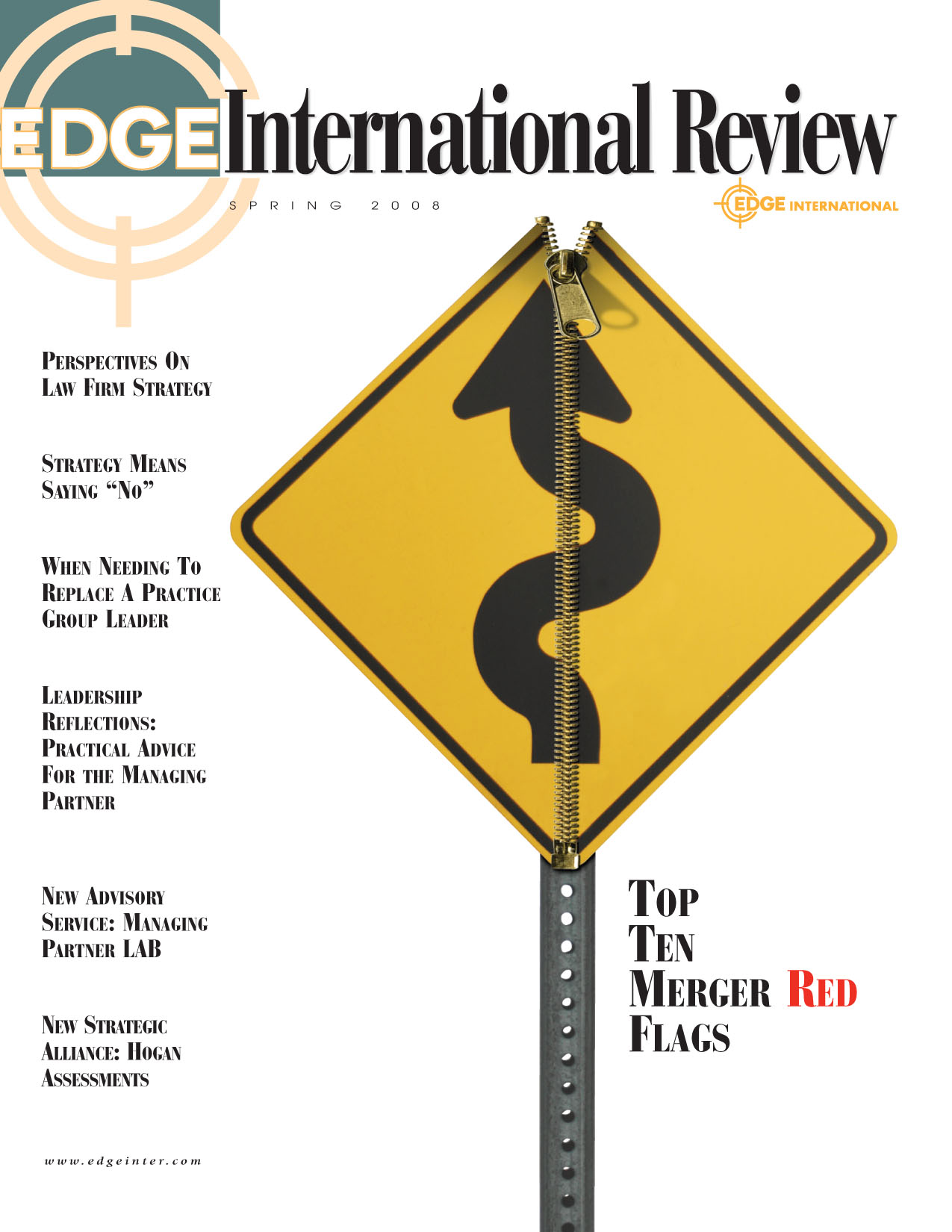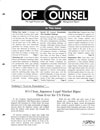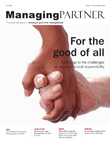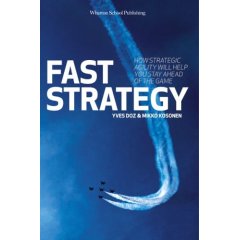
|
http://www.patrickmckenna.com/blog
Page << Prev 60 61 62 63 64 65 66 67 68 69 Next >> of 95
Post #301 – Wednesday, April 16, 2008
More on Law Firm Boards
Subsequent to my post #290 on March 20th, I received this e-mail from one of the premiere law firms in the Netherlands:
Hi Patrick, as you know, I am a regular reader of your blog and I came across the one about Law Firm Boards. You mention all UK examples but NautaDutilh could be mentioned as one of the leading European examples. On May 25, 2007, we announced: Jean Frijns was nominated as member of the Supervisory and Advisory Committee (TAC) of NautaDutilh. The TAC advises the board of NautaDutilh with respect to strategy and oversees the policies and general affairs of the company. One and a half years ago, an external managing director was added to the board, next to lawyers, notaries and tax experts. Considering the ongoing professional developments within NautaDutilh, the nomination of an external member of the TAC was in line with this. Jean Frijns was educated at Tilburg University where he also obtained his doctorate degree in Economic Sciences. In 1988 he joined ABP, the largest civil pension fund in the Netherlands and became CEO of ABP Vermogensbeheer in 1993. In 2004, he was nominated chairman of the Monitoring Commission Corporate Governance Code. Jean Frijns has published numerous works in the field of econometrics, financial markets and pensions. NautaDutilh Chairman Marc Blom comments: "We are delighted with the nomination of Jean Frijns. He masters exceptional expertise in a variety of areas which will be very valuable to us when addressing topics in our board. Moreover, we are very proud that he is willing to commit himself to NautaDutilh through his position in the TAC."
Moreover, you will be happy to hear that the nomination of an external person to the Advisory Committee and to the Board are a direct result of your advice a few years ago. All the best, Jo Vanwittenbergh
Post #300 - Wednesday, April 16, 2008
Positive Things

Post #299 – Thursday, April 10, 2008
Spring Issue of EIR Available

Just returned from an assignment in Washington DC where I was pleased to see the Spring 2008 issue of Edge International Review (our 24-page quarterly journal) arriving on the desks of managing partners.
As the firm leader I was meeting with commented, this issue contains five pragmatic articles representing a nice blend of contributions covering the subjects of law firm leadership and competitive strategy.
I believe he has got that exactly right!
Post #298 - Thursday, April 10, 2008
Taking Charge
 The April 2008 issue of Of Counsel includes a 4-page interview with four managing partners: Barry Needleman from McLane Graf; Thomas Froehle the chief executive partner at Baker & Daniels; Ira Kaplan leader of Cleveland’s Benesch Friedlander; and David Baca from Davis Wright Tremaine in Seattle. According to the article, what all of these lawyers had in common was that were new to the role of being a firm leader, shared similar challenges, and all were extremely gracious in reciting some of the various things they learned about how to effectively tackle their leadership role from attending one of my First 100 Days master classes. The April 2008 issue of Of Counsel includes a 4-page interview with four managing partners: Barry Needleman from McLane Graf; Thomas Froehle the chief executive partner at Baker & Daniels; Ira Kaplan leader of Cleveland’s Benesch Friedlander; and David Baca from Davis Wright Tremaine in Seattle. According to the article, what all of these lawyers had in common was that were new to the role of being a firm leader, shared similar challenges, and all were extremely gracious in reciting some of the various things they learned about how to effectively tackle their leadership role from attending one of my First 100 Days master classes.
According to Of Counsel, “McKenna knows a thing or two about the concerns of managing partners. He’s written a book about law firm leadership transition. In addition for the last two years, he’s conducted seminars to prepare incoming leaders about their what they should expect of their new roles and how they might best meet those demands.”
My next First 100 Days session is scheduled for August and will be back in the Gleacher Center at the University of Chicago School of Business. Shoot me a note if you would like to obtain a copy of the agenda.
Post #297 - Friday, April 4, 2008
The Elite Law Firm
 In an interview, earlier this week with one of the leading legal journalists, we got talking about what constitutes an elite law firm. From our discussions I’m of the opinion that a truly elite law firm must possess most all of these eight (8) attributes: In an interview, earlier this week with one of the leading legal journalists, we got talking about what constitutes an elite law firm. From our discussions I’m of the opinion that a truly elite law firm must possess most all of these eight (8) attributes:
1. A strong New York-centric financial services presence;
2. Critical mass - size is important and an elite firm has critical mass domestically in New York and California; and internationally in London;
3. Name recognition - whether a dominant boutique like a Wachtell Lipton or a full service player like Skadden Arps, client's recognize the firm for what it is world class best at;
4. Highest-value work from Signature clients - elite firms are seen to represent a good portion of the largest Fortune 500 companies for their highest-value legal work;
5. Thought leader - the firm is known to be out in front with developing new areas of practice as well as for having handled various precedent setting cases;
6. Media acknowledgment - legal journalists and reporters know that this is the firm to go to, to get commentary on cutting-edge matters;
7. Proprietary processes - an elite firm is known for it's unique approach to handling certain types of important legal matters (poison pill);
8. Fee leadership - the elite are among the first to raise their fees, enjoy the privilege of premium billing, and the last to tolerate discounts.
Anyone care to modify or propose any additional attributes?
Post #296 - Friday, April 4, 2008
Uniting The Virtual Workforce
Ever get the feeling that your project isn’t running well but you can’t seem to put your finger on the cause? That vague feeling of misunderstanding is often difficult to quantify, define, and diagnose. Nonetheless, misunderstandings and ambiguous communication are important issues that can drive even well-run projects into failure.
As our society continues its transition from the Industrial Age to the Digital Age, new challenges are being introduced into the workplace. Organizational models are shifting toward large, global networks of employees connected to each other through technology, giving rise to a new phenomenon, Virtual Distance. Virtual distance includes three major axes: physical distance, operational distance, and affinity distance. Virtual distance creates real challenges to innovation, leadership, and overall performance and companies that know how to manage the impact of virtual distance will have a big competitive advantage.
 No one understand these issues better than my dear friend (and co-conspirator), Dr. Karen Sobel Lojeski. No one understand these issues better than my dear friend (and co-conspirator), Dr. Karen Sobel Lojeski.
In my Post #228 of August last year, I talked about my work with Karen and how we had the opportunity to co-present at a Globalization Conference and collaborate on a couple of client assignments. Karen is CEO of Virtual Distance International, a consulting firm specializing in measuring and managing the impact of virtual distance in the workforce, a contributing writer to CIO Insight.com, and a popular speaker on virtual distance and the impact it has on today’s workplace.
I am proud and delighted to be acknowledged in her new book, Uniting the Virtual Workforce, and to have written a testimonial for the back cover. This is yet another very promising new release due out next week. Don’t miss this one!
Post #295 - Friday, April 4, 2008
Managing Partner Magazine
The current issue (Volume 10, Issue 10) of the Managing Partner Magazine (US edition) is now out.
In the first question posed, our Leadership Advisory Board [the LAB] provides advice to those new firm leaders who are facing the challenges of potentially going through an economic slowdown for the first time.
Post #294 - Thursday, April 3, 2008
How Agile Is Your Strategy Process?
 Many firms suffer from strategic sclerosis without knowing it. They are often victims of their own success. They die, not because what they did was wrong, but because they kept doing it for too long. Furthermore, the strategy process itself may well have decayed, from a healthy substantive approach to strategic choices into a routine yearly exercise where form wins over substance. Many firms suffer from strategic sclerosis without knowing it. They are often victims of their own success. They die, not because what they did was wrong, but because they kept doing it for too long. Furthermore, the strategy process itself may well have decayed, from a healthy substantive approach to strategic choices into a routine yearly exercise where form wins over substance.
Some organizations are more strategically agile than others, meaning they are better equipped to meet the changes that are taking place at an ever-increasing rate. Yves Doz and Mikko Kosonen draw on extensive research to identify three key enabling capabilities that make a firm strategically agile: strategic sensitivity, leadership unity and resource fluidity. I gratefully received an advanced copy of and share here, an article that draws on research from their new book: Fast Strategy, expected in the book stores next week.
Post #293 - Friday, March 28, 2008
How Well Do You Know Your Key Client?
Do you know what your most valuable client spends on outside legal counsel or what their top objectives are for the year? Here are the answers from one General Counsel, Mark Chandler, who is charged with managing Cisco’s Legal Department:
1. Do you know how big the legal department is and how much they spend on outside counsel?
Legal department facts:
4.7 employees per billion of revenue
Total legal spend is about .38% of company revenue per year
Non-litigation spend is about .16% per year
Internal spend is $38M per year
Outside counsel spend is $80 million per year
2. Do you know how the legal department fits with the other departments in the company?
Legal Department is:
Required to run just as any other corporate department
Expected to be as metrics-driven as Manufacturing, HR, and Sales
3. Do you know the top (three) objectives that General Counsel has set for the legal department in 2008?
Challenges:
- Measured to drive costs down
- Globalization
- Increasing oversight and complexity
- Compliance
- Commoditization of Legal work
In a time of economic uncertainty you need to get even closer to your most important clients . . . and even more so if you didn’t have the foggiest idea how that client might answer all of the above questions.
Post #292 - Friday, March 28, 2008
Law Firm of the 21st Century

I received an interesting note from David Gray. David is the Chief Executive of Eversheds, a 2000-lawyer UK-based firm with 36 offices in major cities across the UK, Europe, Middle East and Asia. Eversheds is among my favorites as an example of how to differentiate your practice in ways that are meaningful to clients. You need only visit their web site to find out more about their precedent-setting success with fixed-fee arrangements, their Rapid Resolution program, and a special training initiative to teach lawyers project management skills.
Anyway, David and his colleagues are now leading the way in a different undertaking. The “Law Firm of the 21st Century” is a study commissioned by Eversheds and outlines the views of partners of top law firms as well as the executives of some of the world’s most prominent companies.
A couple of highlights:
• The majority of partners (73%) believe that the Legal Services Act [UK] will not result in significant changes.
• A third (34%) of the clients interviewed specifically mentioned plans to buy legal services from more firms outside the magic circle.
• The vast majority of partners (82%) and clients (86%) believe that hourly rates will be alive and well in ten years’ time.
• Over half (56%) of clients and (45%) of partners did not think that flexible working could be a realistic solution to work-life balance issues.
• Diversity is theoretically a hot topic for leading firms. However, it did not figure strongly in the research suggesting it is not as high a priority as some would like to suggest.
You might want to get a copy of this study. It is available at no charge, directly from Eversheds.
Page << Prev 60 61 62 63 64 65 66 67 68 69 Next >> of 95
|
|


 Ashridge House
Ashridge House  11226 - 60 Street
11226 - 60 Street  Edmonton, Canada
Edmonton, Canada  T5W 3Y8
T5W 3Y8